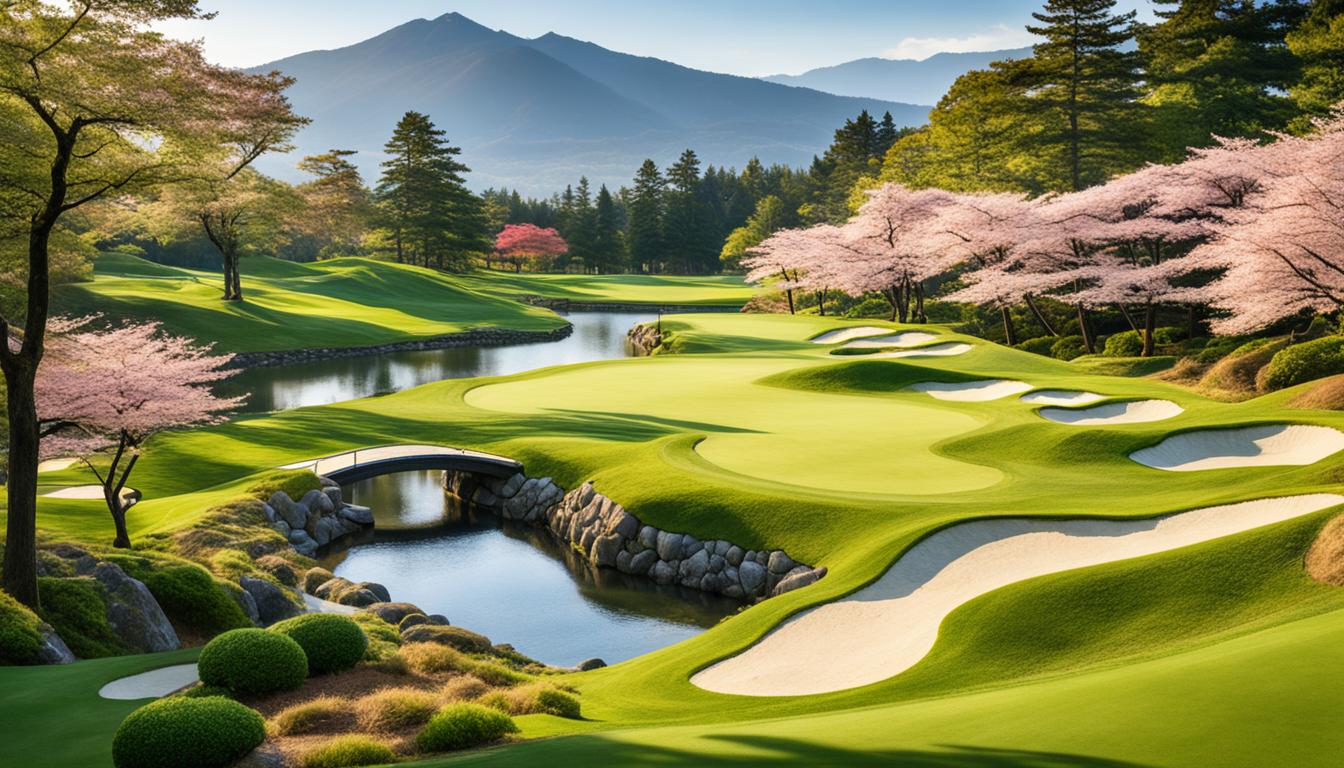Did you know Japan is home to an astonishing 3,140 golf courses? This makes it the second-largest golfing destination globally. This fact underscores Japan’s profound affection for golf, setting the stage for an unforgettable golf outing.
Golfing in Japan is a unique experience. The country’s premier golf courses combine challenging layouts, stunning scenery, and top-notch service. Whether you’re a pro or a beginner, these courses welcome players of all levels. They often provide rental equipment, ensuring you’re ready to play.
From the elite Hirono Golf Club, likened to Pine Valley, to the scenic Kawana Hotel Fuji Golf Course with its breathtaking Pacific Ocean views, Japan’s golf courses are diverse and captivating. They rival some of the best golf courses in Wales and beyond, each offering unique challenges and beauty.
Exploring Japan’s top golf courses unveils a rich history and culture of golf. From the historic Naruo, established in 1920, to the modern Kasumigaseki Country Club, which hosted the 2020 Olympic golf event, Japan’s golf scene reflects its lasting passion for the sport.
Key Takeaways
- Japan is home to over 3,140 golf courses, second only to the United States
- Japanese golf courses cater to all skill levels and often provide rental equipment
- Hirono Golf Club is considered one of Japan’s top courses, rivaling international favorites
- Many courses offer stunning views, including ocean vistas and Mount Fuji scenery
- Japan’s golfing landscape includes historic courses and modern Olympic-grade facilities
- Green fees vary widely, with some courses accessible for as low as 7,300 Yen (£48)
- Japan’s golf courses surpass the total number found in the rest of Asia combined
Table of Contents
- 1 Introduction to Golf in Japan
- 2 Hirono Golf Club (Hyogo): Japan’s Crown Jewel
- 3 Kawana Hotel Fuji Golf Course (Shizuoka): A Scenic Masterpiece
- 4 Kawana Hotel Oshima Golf Course (Shizuoka)
- 5 Tokyo Golf Club (Saitama): Tradition Meets Modern Design
- 6 Naruo Golf Club (Hyogo): A Hidden Gem in Hyogo
- 7 Ono Golf Club: Challenging Greens in Natural Splendor
- 8 Yokohama Country Club: Urban Golfing Excellence
- 9 Kasumigaseki Country Club (Saitama): Olympic-Grade Golfing
- 10 Osaka Golf Club: A Coastal golf outing
- 11 Ibaraki Country Club (Osaka)
- 12 Phoenix Country Club (Miyazaki)
- 13 Golfing Etiquette in Japan: What You Need to Know
- 14 Seasonal Considerations for Golfing in Japan
- 15 Golf Course Accessibility for International Visitors
- 16 Combining Golf with Japanese Culture: Nearby Attractions
- 17 Golf Equipment Rental and Purchase Options in Japan
- 18 The Future of Golf in Japan: Emerging Courses and Trends
Introduction to Golf in Japan
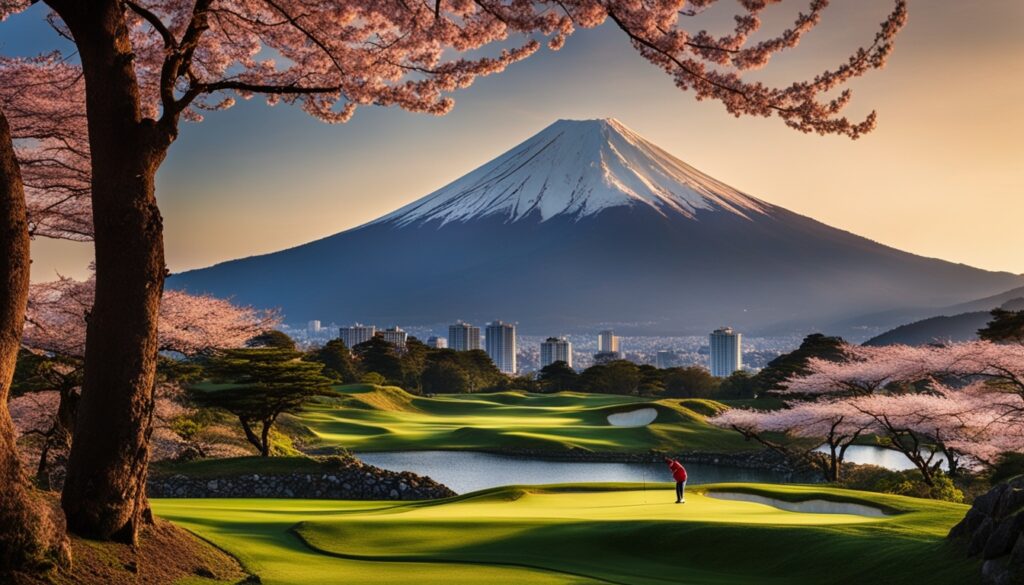
Golf in Japan has transformed from a niche activity to a beloved national pastime. The journey began in 1903 with the establishment of its first club. Today, Japan ranks third globally in terms of golf courses, after the United States and Canada. This surge underscores the profound influence of Japanese golf culture over the last century.
The Rise of Golf in Japanese Culture
Golf has woven itself deeply into Japanese life, with courses dotting the landscape. The sport’s appeal is clear in its pricing, with weekday rounds costing between 7,000 and 12,000 yen. Weekends and peak seasons bring higher rates, particularly near major cities. This shift marks a move from exclusivity to inclusivity in Japanese golf.
Japan’s Position in the Global Golfing Landscape
Japan has established a distinctive presence in global golf. Its courses are celebrated for their strategic bunkering, tree-lined fairways, and seamless integration with nature. These elements offer a challenging yet exhilarating experience for golfers at all levels. In the Kanto region, golfers can find a variety of courses, including 18-hole and 27-hole layouts, with some boasting yardages of up to 7,197 yards for the blue tees.
Unique Features of Japanese Golf Courses
Japanese golf courses are distinguished by their meticulous attention to detail and adherence to tradition. Dress codes are strictly enforced, mandating collared shirts and proper golf attire. While English-speaking caddies are scarce, many courses offer rental clubs and caddie services for an extra fee. For solo players, the hitori-yoyaku service allows booking rounds with other singles at select venues. These distinctive features make the golfing experience in Japan unique, setting it apart from other global destinations.
Hirono Golf Club (Hyogo): Japan’s Crown Jewel
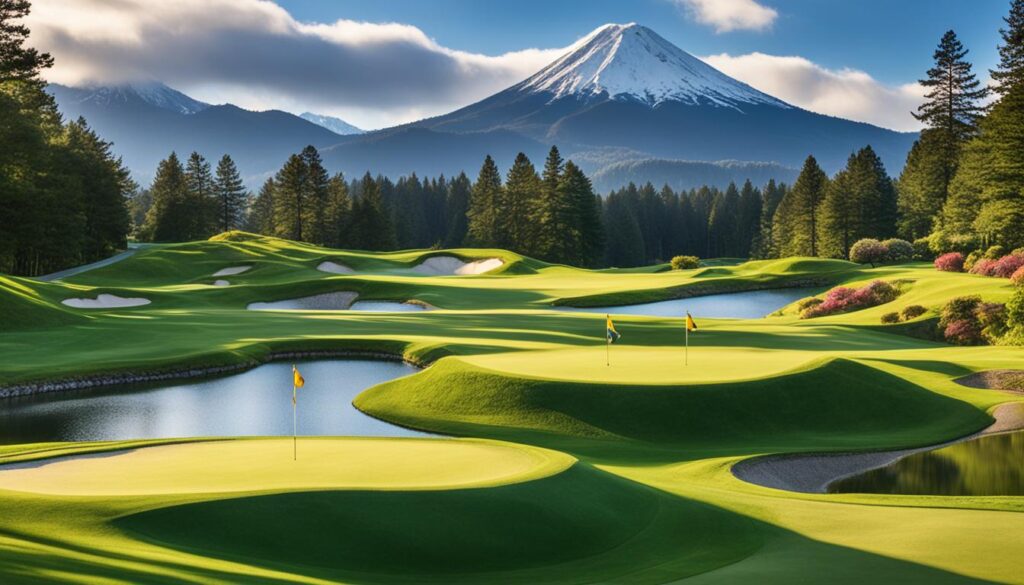
In Hyogo Prefecture, Hirono Golf Club is a top-ranked Japanese course. Established in 1932, it features a Charles Hugh Alison design that has enthralled players for generations. This golfing paradise showcases the brilliance of Alison’s vision.
The course is known for its strategic bunkering, sandy terrain, and tree-lined greens. These elements make the game both challenging and rewarding for golfers at any level. The layout leverages the natural landscape, offering stunning views at every turn.
Worldwide, golf enthusiasts hail Hirono as one of the premier courses. It consistently ranks among the top 100 globally, solidifying its position as Japan’s golfing gem. The meticulous course maintenance and preservation of Alison’s original design enhance its timeless allure.
| Day | Visitor Rate (¥) |
|---|---|
| Weekdays | 15,730 |
| Saturdays | 20,130 |
| Sundays | 25,630 |
When planning your visit, consider the varying rates. Weekday play is more economical, while weekends are pricier. Yet, every round at this iconic course promises an unforgettable experience at one of Japan’s most esteemed golfing spots.
Kawana Hotel Fuji Golf Course (Shizuoka): A Scenic Masterpiece

In Shizuoka, the Kawana Hotel Fuji Golf Course epitomizes golfing excellence. It provides an unforgettable experience for both avid golfers and casual players. This scenic golf resort is a haven for those seeking a unique golf outing.
History and Design
Since its opening in 1936, the Kawana Fuji Golf Course has been a masterpiece. Renowned English designer C.H. Alison crafted the course, blending it flawlessly with the natural surroundings. Often hailed as ‘Japan’s Pebble Beach,’ it ranks among the globe’s elite courses.
Notable Features and Challenges
The course offers breathtaking Pacific Ocean views, enhancing the game’s beauty. Each hole presents distinct challenges, testing your skills and rewarding strategic play. The design leverages the natural terrain, offering a genuine and challenging golfing experience.
Booking Information and Fees
Planning ahead is essential to secure a spot at this exclusive course. The Kawana Hotel Fuji Golf Course has limited tee times for visitors. As of 2023, the green fee stands at ¥41,100. This fee grants access to the luxurious facilities of the Kawana Hotel, ideal for a golf retreat.
| Feature | Detail |
|---|---|
| Designer | C.H. Alison |
| Year Opened | 1936 |
| Course Ranking | Top 100 Worldwide |
| Green Fee | ¥41,100 |
The Kawana Fuji Golf Course presents an unmatched golfing experience. Its historical significance, picturesque views, and challenging layout solidify its status as a premier destination for golf lovers in Japan.
Kawana Hotel Oshima Golf Course (Shizuoka)
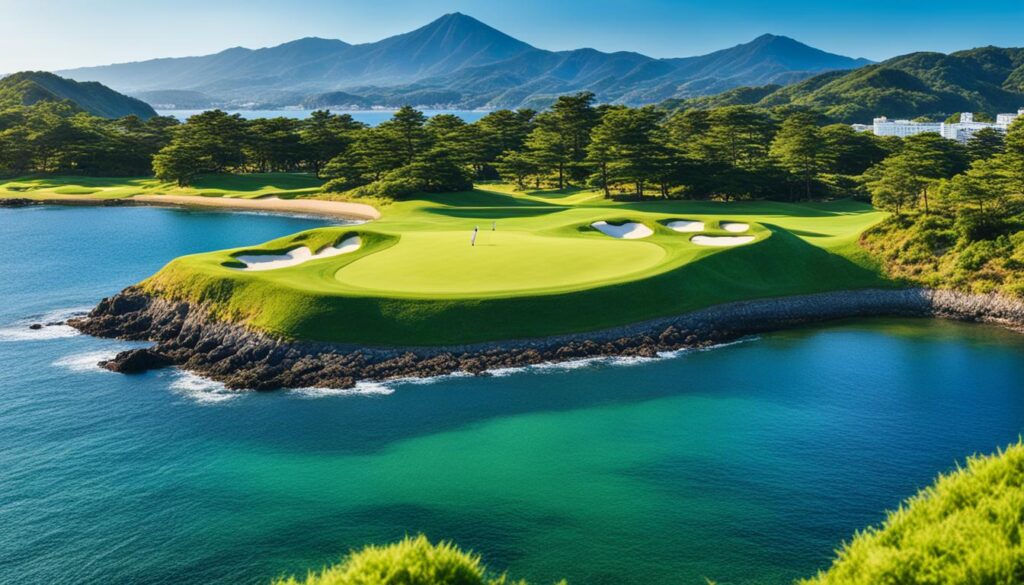
The Kawana Hotel Oshima Golf Course in Shizuoka presents a quintessential Japanese golf outing. Designed by Mitsuaki Otani in 1933, this 18-hole course stretches over 5,711 yards with a par of 70. It harmoniously complements its sister course, Fuji, offering unique challenges and spectacular views of Sagami Bay.
Players delight in Zoysia grass fairways and greens, navigating a moderately challenging course. With a slope rating of 113 and a course rating of 67.2, it accommodates a broad range of skill levels. The layout is marked by several standout holes, including the steep uphill 3rd, the 4th’s elevation shift, and the dogleg left 6th, which demands a precise second shot over a ravine.
The back nine unveils Shizuoka’s coastal splendor. The 10th hole, a downhill par 4, presents breathtaking ocean vistas. The 11th, a 199-yard par 3, and the 15th, a short par 3 over a ravine, deliver memorable seaside golfing experiences.
Though considered second-tier to the Fuji layout, the Oshima Course has its distinct allure. Reviewers commend its welcoming atmosphere and superb green conditions. The course’s amenities are highly rated, elevating the overall experience at this historic Kawana Hotel venue.
For those planning a Shizuoka golf trip, the Kawana Hotel Oshima Course is approximately 2.5 hours from Tokyo by car or 4 hours via public transport. This outing culminates in a golfing destination that masterfully fuses Japanese tradition with coastal grandeur.
Tokyo Golf Club (Saitama): Tradition Meets Modern Design
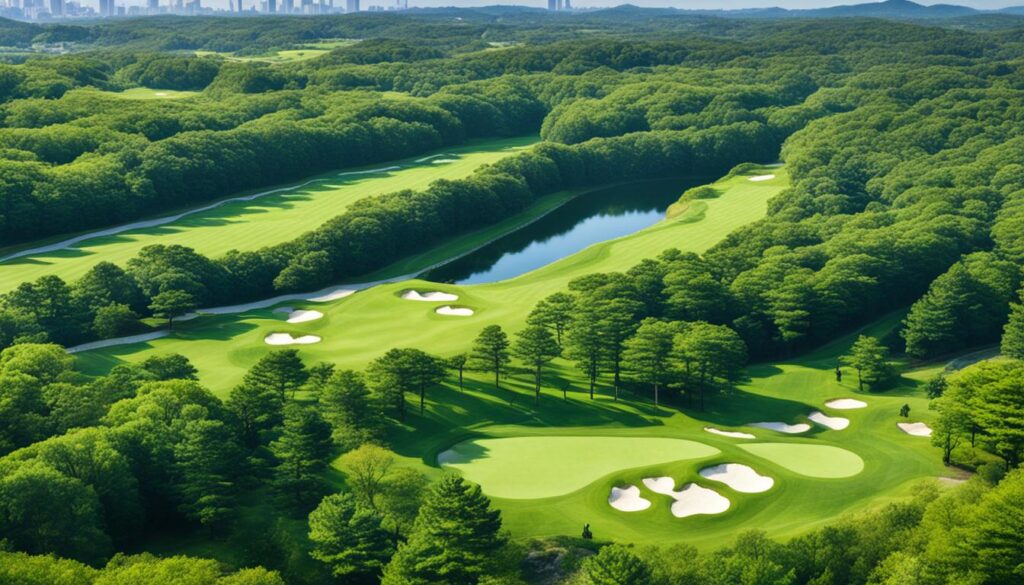
The Tokyo Golf Club is a cornerstone of Japan’s golfing legacy. Founded in 1913, it is the oldest Kanto golf club. Nestled in Saitama Prefecture, it seamlessly merges tradition with modern design.
The club introduced its Asaka course in 1932, a work of art by Komyo Ohtani. This course, with its demanding layout and traditional Japanese feel, has enthralled golfers for many years. A major renovation by Gil Hanse in 2013 revitalized this historic venue.
Though mainly for members, the club welcomes guests on weekdays with a member’s introduction. This approach ensures its exclusivity while offering a rare chance for outsiders to experience Japan’s prestigious golfing.
| Feature | Description |
|---|---|
| Established | 1913 |
| Course Designer | Komyo Ohtani |
| Renovation | Gil Hanse (2013) |
| Access | Members and guests with introduction |
| Playing Days | Weekdays for guests |
Golf lovers visiting Japan must play at the Tokyo Golf Club. Its deep history and challenging layout are unparalleled. For those looking for golf outings beyond Japan, there are many world-class courses to explore.
Naruo Golf Club (Hyogo): A Hidden Gem in Hyogo
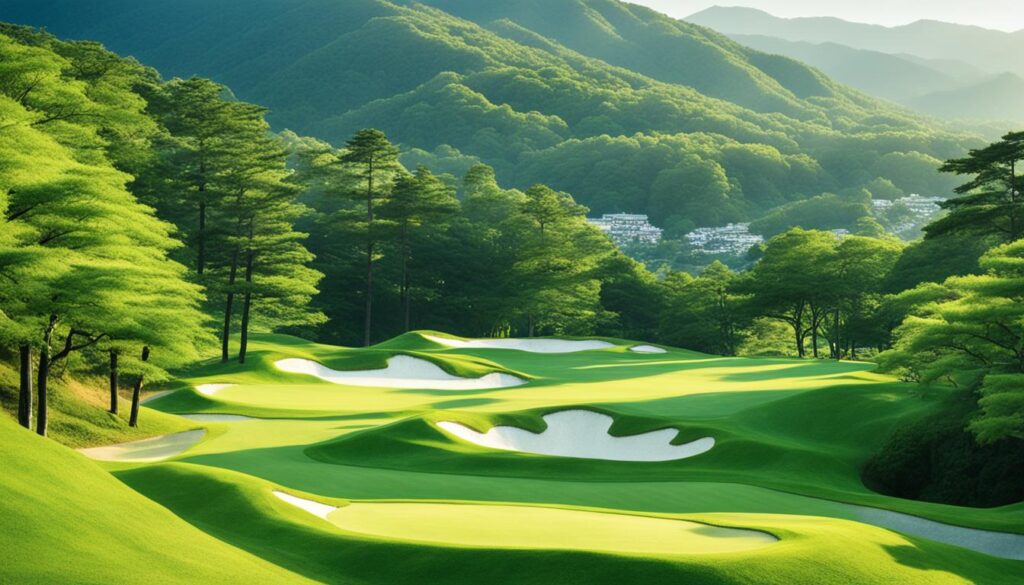
Naruo Golf Club is a cornerstone of Japan’s golfing legacy. Established in 1920 and reestablished in 1930, it harmoniously blends tradition with challenge. This esteemed course is a testament to the country’s deep golfing roots.
Course Layout and Characteristics
The Ina River Course, designed by Joseph Earnest Crane, exemplifies his design prowess. It incorporates native landscapes, offering a dynamic experience for golfers. The course is marked by several standout holes:
- Hole 1: Set in a Japanese garden
- Hole 3: A downhill par 4
- Hole 9: Blind tee shot
- Hole 10: Requires precision over bunkers and water
- Hole 14: Challenging par 5
- Hole 15: Dramatic par 3
- Hole 16: Strong par 4
- Hole 17: Demands accuracy to a small elevated green
Visitor Policies and Access
Naruo Golf Club is predominantly a members-only establishment. However, visitors can access the course on weekdays with a member’s introduction. This exclusivity enhances its allure, making it a coveted spot for golf aficionados.
Historical Significance
Ranked among Japan’s elite and globally in the top 100, Naruo Golf Club is a testament to its historical and design excellence. Charles H. Alison’s insights significantly influenced its layout, defining Japan’s golfing culture. Its storied past and exceptional design continue to draw international golfers.
| Feature | Description |
|---|---|
| Founded | 1920 |
| Relocated | 1930 |
| Designer | Joseph Earnest Crane |
| Course | Ina River Course |
| Global Ranking | Top 100 |
| Japan Ranking | Top 5 |
Ono Golf Club: Challenging Greens in Natural Splendor
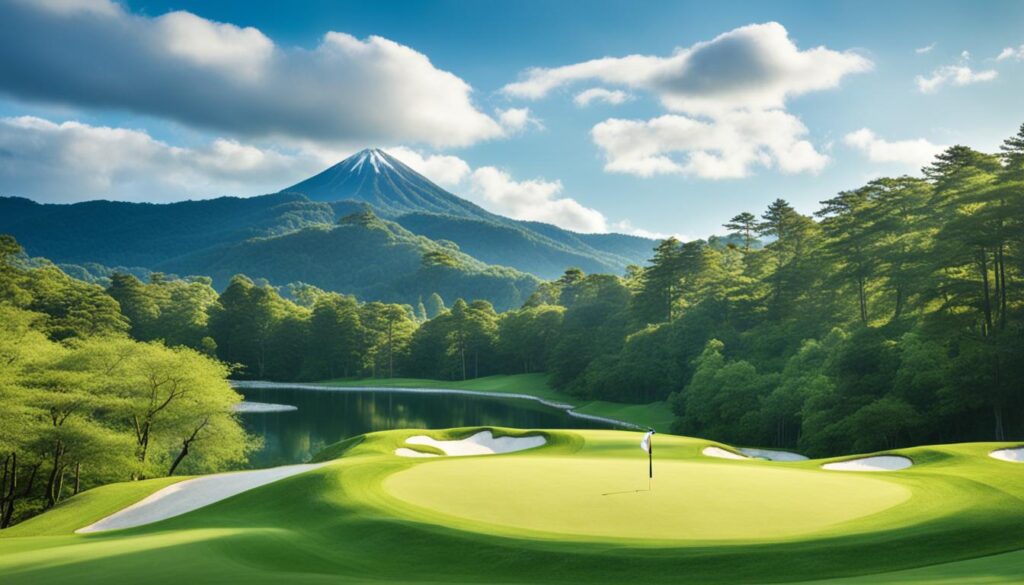
Located within Harima Chubu Hill Prefectural Natural Park, Ono Golf Club offers a unique golfing experience. Designed by Osamu Ueda in 1961, it has become a top choice for golfers and professionals. The club’s design blends seamlessly with the natural surroundings, creating a memorable golfing experience.
The course features a traditional garden-like atmosphere, winding around the scenic Kamo Lake. This setting offers breathtaking views and a challenging game. Osamu Ueda’s design incorporates natural elements, making the course both beautiful and demanding.
Golf enthusiasts will recognize the course’s prestige. It has hosted major tournaments like the Japan Open and Kansai Open. The challenging greens and strategic hazards ensure every round is thrilling.
| Day | Visitor Rate |
|---|---|
| Weekdays | ¥23,250 |
| Saturdays | ¥28,750 |
| Sundays | ¥32,050 |
Plan your visit to Ono Golf Club for an unforgettable experience. Osamu Ueda’s design, set against Harima Chubu Hill, promises a day of exceptional golf. Whether you’re a pro or a weekend golfer, this course will leave a lasting impression.
Yokohama Country Club: Urban Golfing Excellence

Yokohama Country Club is a top-tier urban golf course near Tokyo. It combines easy access with a superior golfing experience. We will look at what sets this club apart.
Course Features and Recent Renovations
The club features two unique courses: East and West. A significant Coore & Crenshaw renovation in 2016 raised its status among Japan’s top courses. This update introduced modern design while honoring its historical roots since its founding.
Pricing Structure and Tee Time Bookings
Greens fees at Yokohama Country Club change with the season and day. They range from ¥11,300 to ¥18,335, competitive with other local courses. Booking tee times is easy through the club’s website, available to members and visitors alike.
Amenities and Facilities
The club enhances your golfing with a variety of amenities. These include:
- Club and shoe rentals
- Golf carts
- Professional caddies
- On-site pro shop
- Dining facilities with course views
| Golf Club | Established | Price Range (¥) |
|---|---|---|
| Yokohama Country Club | 1968 | 11,300 – 18,335 |
| Atsugi Kokusai Country Club | 1959 | 17,400 – 30,945 |
| Checkmate Country Club | 1983 | 11,000 – 16,532 |
| Chigasaki Golf Club | 1957 | 12,580 – 19,980 |
| Dai-Atsugi Country Club Hon Course | 1970 | 11,850 – 22,150 |
Kasumigaseki Country Club (Saitama): Olympic-Grade Golfing
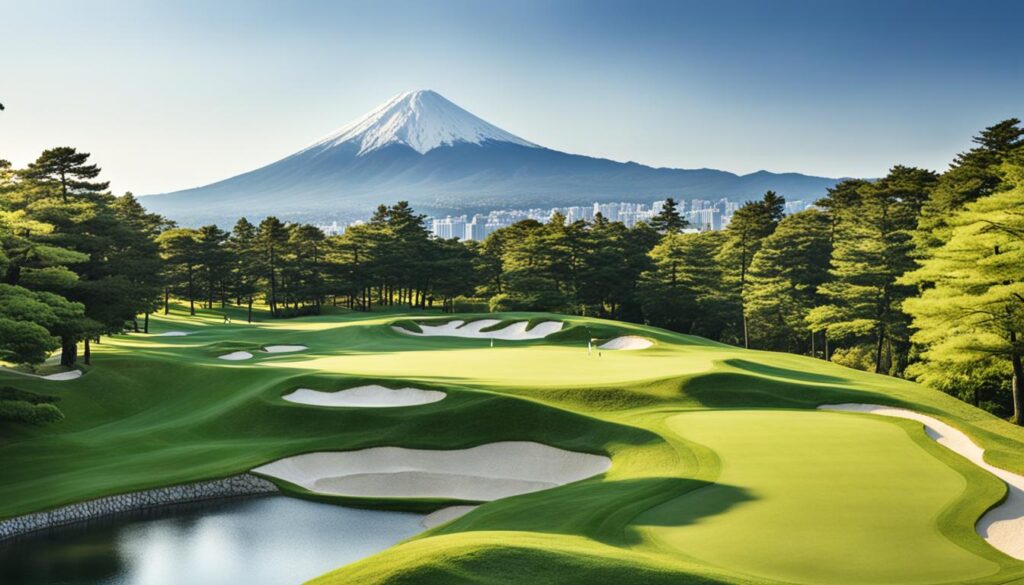
Kasumigaseki Country Club is a cornerstone of Japan’s golfing legacy. Established in 1929, it ranks as the fourth oldest course in the Kanto region. The club offers 36 holes across its East and West courses, catering to golfers at every skill level.
The club’s East and West courses were the stage for the 2020 Tokyo Olympics, elevating its global prestige. With its 120 bunkers and small greens, set against the backdrop of ponds and pine forests, Kasumigaseki challenges even the most seasoned players.
Architects C.H. Alison, Tom Fazio, and Logan Fazio have refined the course over the years. The East and West courses feature Zoysia grass fairways and Bent grass greens, ensuring optimal playing conditions throughout the year.
| Course Details | East Course | West Course |
|---|---|---|
| Par | 71 | 72 |
| Length (yards) | 7466 | 7186 |
| Rating | 74.9 | 73.8 |
| Slope | 131 | 129 |
Kasumigaseki Country Club has been the venue for four Japan Open tournaments, drawing golfers from across the globe. For those planning a visit, note that reservations are essential and must be made by members 2-3 months in advance. This reflects the club’s exclusivity and enduring appeal.
Osaka Golf Club: A Coastal golf outing
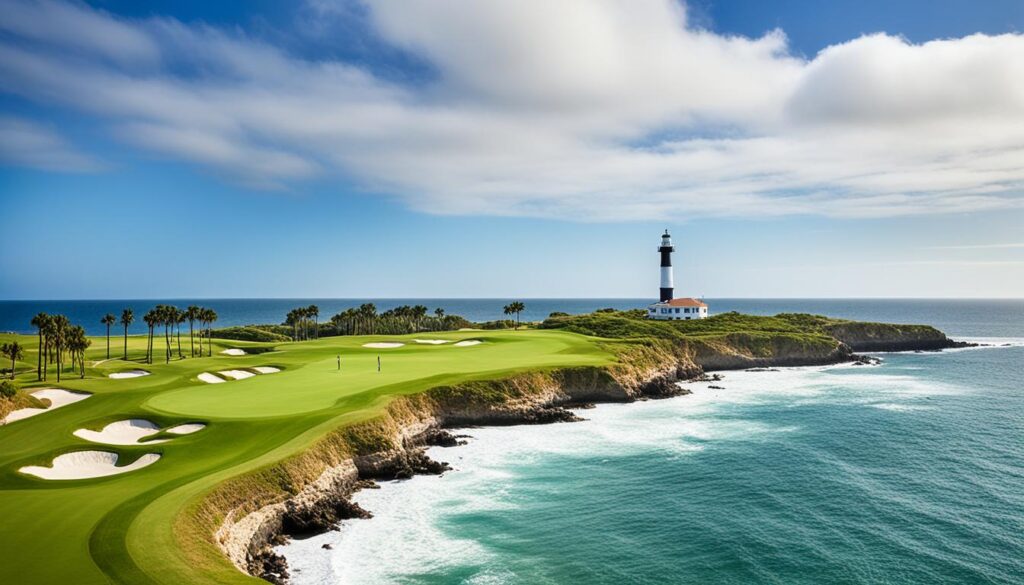
Located in the picturesque Iwate prefecture, the Osaka Golf Club presents a distinctive coastal golf outing. It shines among Japan’s 2,308 golf courses, attracting players from all over the country and abroad.
Unique Course Design Elements
Osamu Ueda’s 1987 design, the Osaka Golf Club, is hailed as his crowning achievement. The course features a three-dimensional layout, complete with challenging mounting greens and Alison-styled bunkers. These elements ensure a demanding yet fulfilling game for golfers at every level.
Scenic Views and Playing Experience
As a coastal course, the Osaka Golf Club offers stunning Pacific Ocean vistas. The sea breeze adds an extra layer of challenge, making each round unique. Golfers can take in the breathtaking scenery while tackling the course’s strategic layout.
Reservation Requirements
To experience this Osamu Ueda masterpiece, reservations are essential. Prices are comparable to other elite courses in the area. For instance, Hanna Country Club’s rates range from ¥13,500 to ¥24,800.
| Feature | Description |
|---|---|
| Design | Osamu Ueda masterpiece |
| Layout | Three-dimensional with mounting greens |
| Bunkers | Alison-styled |
| Views | Pacific Ocean vistas |
| Challenge | Sea breeze influence |
When planning a golfing trip to Japan, don’t forget to explore other areas. Baltimore, Maryland boasts 36 diverse courses within a 15-mile radius, offering a unique golfing experience across the Pacific.
Ibaraki Country Club (Osaka)
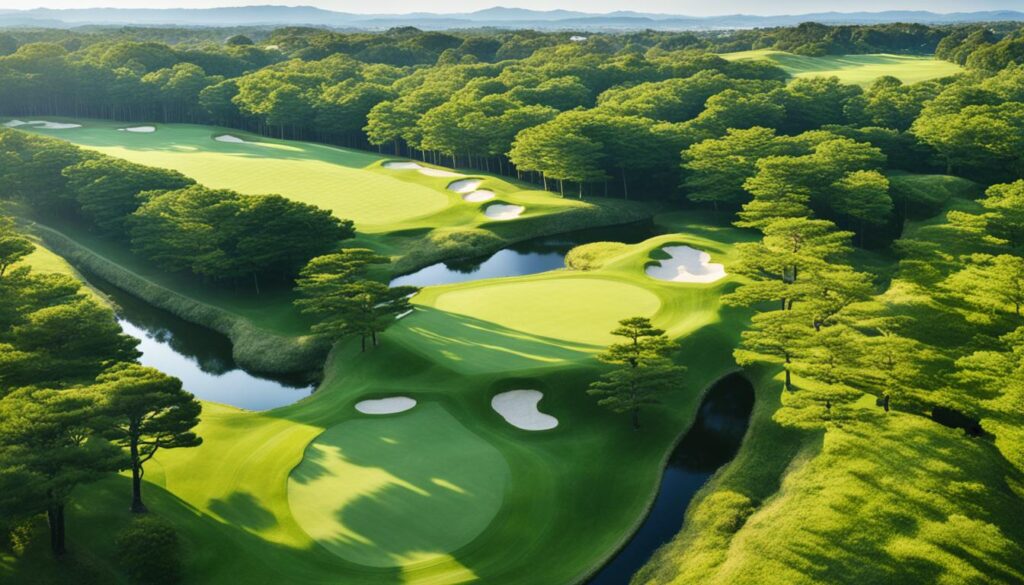
Ibaraki Country Club is a top choice for golfers in Osaka. It boasts a 36-hole facility near Osaka, catering to all skill levels. This place offers a diverse golfing experience.
The West Course at Ibaraki Country Club was revamped by Rees Jones, a renowned architect. This was Jones’ first project in Japan, bringing a new vision to Japanese golf. The redesign removed dual greens, focusing on a single target for each hole.
With five sets of tees, the course spans from 5,455 to 7,407 yards. This range offers a thrilling challenge for golfers of all abilities. Jones chose a neo-classic style, featuring varied greens and rectangular tees.
The course now incorporates Kamiga Lake into several holes, enhancing both its look and playability. Members appreciate the classic, strategic layout that respects modern standards and the natural terrain.
Ibaraki Country Club is a leading Osaka golf course, aiming to host major professional events. Its strategic location near Japan’s second-largest city draws both local and international golfers.
When planning your Osaka golf trip, don’t miss out on Ibaraki Country Club. It seamlessly combines traditional Japanese golf culture with modern design. This unique blend makes it a standout among Japanese country clubs.
Phoenix Country Club (Miyazaki)

Phoenix Country Club is a standout among Miyazaki golf courses, offering a premier southern Japan golfing experience. It highlights the unique allure of golf in the region, with its lush landscapes and favorable climate.
The course layout at Phoenix Country Club leverages Miyazaki’s natural beauty. Golfers can revel in stunning Pacific Ocean views while tackling challenging holes designed for all skill levels.
For those in pursuit of top-tier Miyazaki golf courses, Phoenix Country Club does not disappoint. Its commitment to excellence is clear, from the course design to the clubhouse amenities.
| Feature | Description |
|---|---|
| Location | Miyazaki Prefecture, Southern Japan |
| Course Type | 18-hole Championship Course |
| Signature Hole | Ocean-view Par 3 |
| Amenities | Pro Shop, Restaurant, Practice Facilities |
| Best Season | Spring and Fall |
At Phoenix Country Club, southern Japan golfing reaches its zenith. The course’s strategic design incorporates local flora, creating a harmonious blend of challenge and beauty. Whether you’re a seasoned pro or a casual player, this Miyazaki gem promises an unforgettable round of golf.
Golfing Etiquette in Japan: What You Need to Know
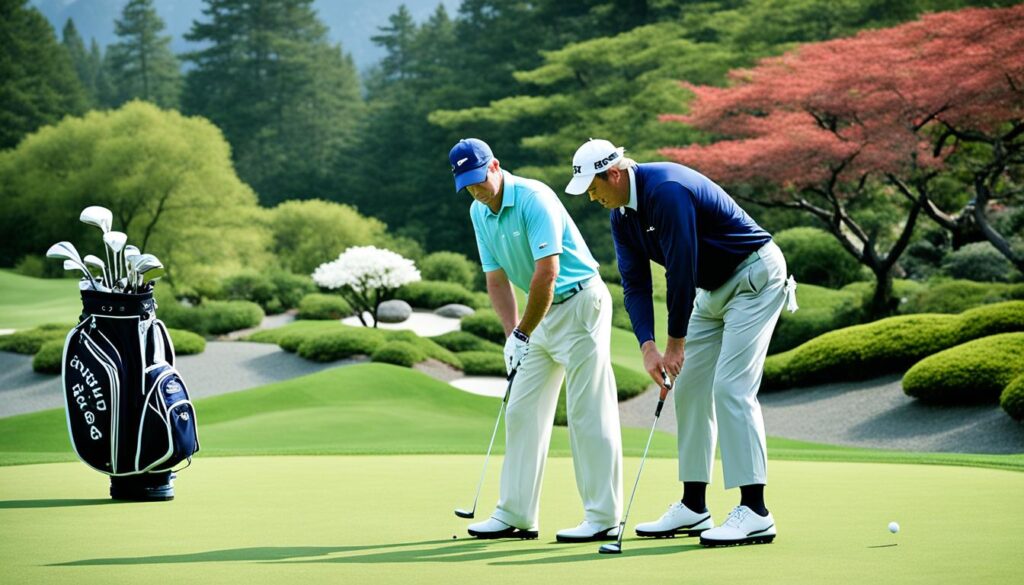
Golfing in Japan combines sport with a deep cultural heritage. The etiquette of Japanese golf places a strong emphasis on respect and tradition. As you play golf in Japan, you’ll encounter customs that might surprise you but will greatly enhance your experience.
The dress code in Japanese golf culture is paramount. At private clubs, long pants are essential, while shorts are generally disapproved of. Upon arrival, wearing a jacket is expected, reflecting the sport’s formal nature in Japan. Being punctual is highly esteemed, so arriving early allows you to fully appreciate the pre-round rituals.
The golfing experience in Japan goes beyond the game itself. Most clubs offer a cup of coffee before the game starts, and after nine holes, players take a break for lunch, which often includes beer and coffee. Post-game, you’ll likely be invited to join a communal hot bath, a cherished tradition among Japanese golfers.
- Use “arigato” (thank you) frequently during your round
- Avoid tipping caddies or staff
- Shower before entering the hot bath
- Don’t expect gimme putts, even for short distances
Understanding these cultural aspects will aid you in navigating golfing in Japan with ease and respect. Embracing these unique customs will help you fully appreciate the rich golfing tradition in the Land of the Rising Sun.
| Japanese Golf Custom | Frequency |
|---|---|
| Long pants required | 90% of private courses |
| Jacket upon arrival | 100% of private clubs |
| Caddie assignment | All courses |
| Lunch break after 9 holes | Standard practice |
| Communal bath post-round | 100% of clubs |
Seasonal Considerations for Golfing in Japan
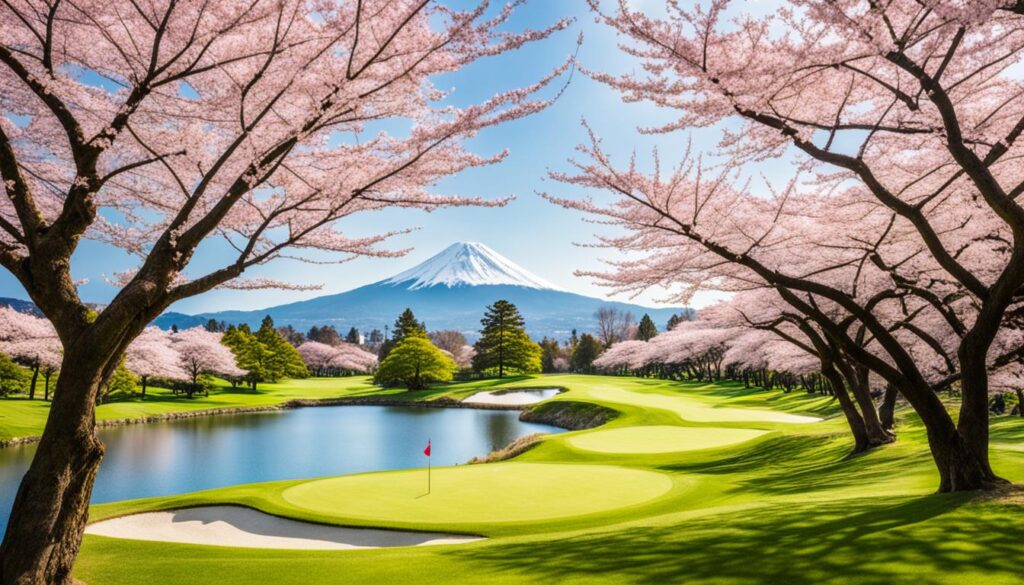
Japan’s golf seasons offer unique experiences throughout the year. Each season brings its own charm to the courses, making golfing in Japan a year-round delight.
Best Times to Visit
Spring and autumn are prime golf seasons in Japan. Spring welcomes cherry blossoms, signaling the start of the golf season. It sweeps from Okinawa in February to Hokkaido by May. Autumn paints courses in vibrant hues, starting in Hokkaido in early October and moving south until mid-December.
Weather Impacts on Course Conditions
Japanese weather greatly influences course conditions. Spring offers lush greens and mild temperatures. Summer can be hot and humid, but courses remain in top shape. Autumn brings cooler temps and stunning foliage. Winter golfing is possible in some regions, with crisp air and clear skies.
Seasonal Events and Tournaments
Golf tournaments in Japan follow the seasons. Spring hosts several major events as courses reopen. Summer sees a bustling tournament schedule. Autumn boasts some of the most prestigious competitions. Even winter has its share of events in warmer regions.
| Season | Highlights | Course Conditions |
|---|---|---|
| Spring | Cherry blossoms, season start | Fresh greens, mild weather |
| Summer | Long days, many tournaments | Lush fairways, possible humidity |
| Autumn | Koyo (fall colors), off-season rates | Cool temps, stunning scenery |
| Winter | Clear skies in some regions | Crisp air, limited availability |
For golf enthusiasts seeking diverse experiences, San Antonio offers exceptional courses with a different climate and landscape. Whether in Japan or Texas, each destination provides unique golf outings.
Golf Course Accessibility for International Visitors

Japan’s golf scene is a treasure trove for international golfers seeking unique experiences. With over 2,000 golf courses across the country, visitor access to Japanese golf clubs has become increasingly accommodating. Many prestigious courses now welcome foreign players, opening doors to world-class golf outings.
The Kansai region offers excellent accessibility for golf enthusiasts. Courses in this area are within an hour’s reach from major cities like Kobe and Osaka, and just over an hour from Kyoto. This proximity makes it easier for international visitors to combine cultural experiences with their golfing trips.
For those eyeing Tokyo’s golf scene, Taiheiyo Club operates 15 golf clubs in the area. While Tokyo courses can be more challenging to access, they’re well worth the effort. The city’s vibrant golf community and top-notch facilities make it a must-visit destination for avid golfers.
Okinawa, with its 27 golf courses, is another hotspot for international golfers. The island’s tropical climate allows for year-round play, making it an ideal destination for those looking to escape colder climates.
| Region | Notable Features | Accessibility |
|---|---|---|
| Kansai | Close to cultural sites | Within 1 hour of major cities |
| Tokyo | 15 Taiheiyo Club courses | Requires advance planning |
| Okinawa | 27 courses, year-round play | Easily accessible for island visitors |
When planning your golfing trip to Japan, remember to book tee times well in advance. Many courses require reservations months ahead, especially for popular destinations. With proper planning, you’ll find Japanese golf clubs offer unforgettable experiences that blend traditional hospitality with world-class golfing.
Combining Golf with Japanese Culture: Nearby Attractions

Japan seamlessly blends golf tourism with cultural exploration. With over 2,200 golf courses, you can easily combine your golf passion with cultural discovery. Many courses are near cultural landmarks, offering a deep dive into Japan’s heritage.
Spring and autumn are the best seasons for golfing in Japan. These seasons provide pleasant weather and beautiful landscapes. Late March to early April is perfect for the cherry blossoms, while autumn showcases vibrant foliage.
While golfing, don’t miss out on nearby cultural sites. Visit ancient temples, unwind in natural hot springs, or savor local cuisine. Japan’s golf courses are more than just places to play; they’re portals to memorable cultural experiences.
| Region | Golf Courses | Nearby Attractions |
|---|---|---|
| Tokyo Area | 400+ | Tokyo Tower, Imperial Palace |
| Kyoto/Osaka | 200+ | Kiyomizu-dera Temple, Osaka Castle |
| Hokkaido | 150+ | Sapporo Beer Museum, Furano Lavender Fields |
| Okinawa | 50+ | Shuri Castle, Churaumi Aquarium |
Golf Equipment Rental and Purchase Options in Japan

Japan’s golf scene is vast, with over 2,350 courses, making it the second-largest market globally. This variety means golfers have numerous options for their gear. Whether you’re a local or a visitor, you’ll find something to suit your needs.
Club Rentals at Major Courses
Many Japanese courses offer golf equipment rental services. You can rent complete club sets and shoes, making it ideal for casual players or those who prefer not to bring their own clubs. This option ensures you can focus on enjoying the game without the hassle of equipment.
Where to Buy Golf Gear in Japan
Buying golf gear in Japan is an exciting venture. Major cities like Tokyo are home to numerous golf shops. Titleist Japan, for example, provides a broad selection of equipment. Their range includes the TSR driver, T-series irons, and the popular Vokey wedges.
For a tailored experience, Titleist Fitting Experience offers English-speaking fitters in Tokyo and Yokohama. It’s advisable to schedule your fitting session ahead of time. The new SM10 Vokey wedges are favored by both professionals and amateurs for their exceptional spin and control.
Shipping Your Own Clubs: Tips and Regulations
If you prefer using your own clubs, shipping them to Japan is an option. However, be mindful of airline regulations and associated fees. Some golfers choose to rent equipment to circumvent the challenges of shipping. Always verify the airline’s rules regarding the transportation of golf clubs.
| Option | Pros | Cons |
|---|---|---|
| Golf Equipment Rental | Convenient, No transport hassle | May not fit perfectly |
| Buying Golf Gear in Japan | Wide selection, Fitting available | Can be expensive |
| Shipping Golf Clubs | Use familiar equipment | Potential damage, Added cost |
The Future of Golf in Japan: Emerging Courses and Trends
The golf industry in Japan is poised for an exhilarating future. As the third-largest golf market globally, it continues to innovate and embrace new trends. With 2,450 golf courses, representing 7.3% of the world’s total, Japan’s dedication to golf remains unwavering.
New courses in Japan are prioritizing accessibility for international players. They now offer English bookings and online reservation systems. This move aims to attract the increasing number of foreign golfers, who are drawn by the lower green fees compared to countries like Korea. Typically, the average cost in Japan is significantly lower, often half or a third of what it is in Korea.
The golf sector in Japan is witnessing a surge in foreign investment. Korean investors are notably active, with about 20 Japanese golf resorts listed on the Korean private equity market. This global interest is set to fuel further enhancements and innovations across Japanese courses.
Looking forward, we anticipate more tournaments drawing in top international talent. Japan’s inaugural PGA TOUR event in 2019, featuring stars like Tiger Woods and Rory McIlroy, set the stage for future success. With 7.6 million golfers, Japan’s fervor for the sport heralds a future replete with thrilling developments and premier golfing experiences.
